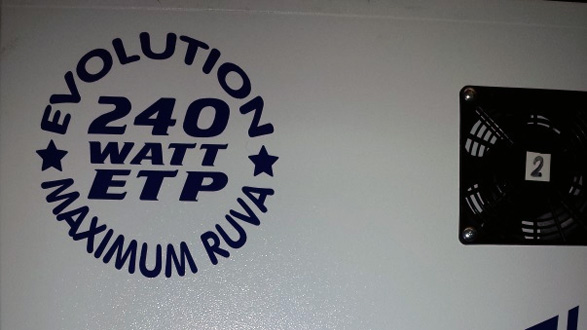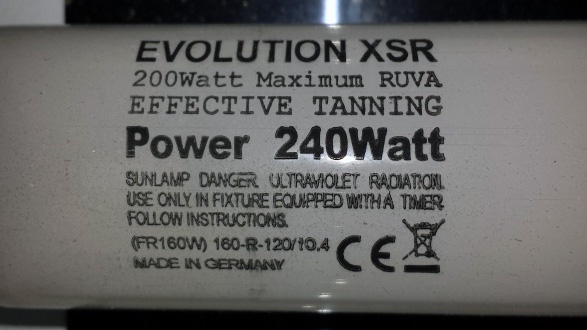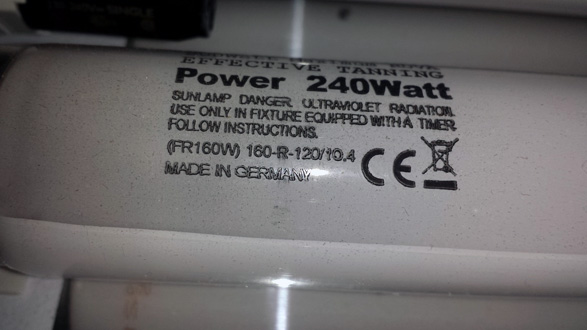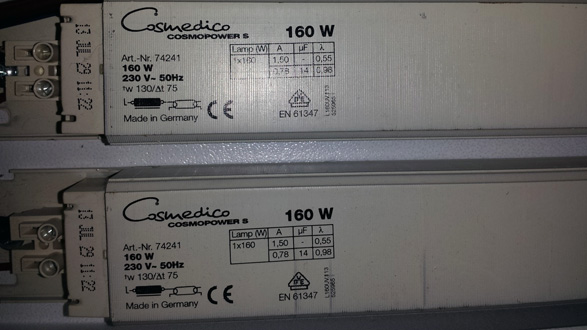One of the most common things I get asked for is a Sunbed fitted with 240 watt tubes. Some people don’t believe me when I say they don’t make a 240 watt tube. I thought I would explain as simply as possible why the ‘240 Watt’ tube is not what it appears to be and help the user see what they are actually getting.
I can understand people’s confusion – when the Sunbed arrives, it has a nice big ‘240’ watt sticker on it.
But what are you actually getting? You will see a photograph of the Evolution XSR ‘240 watt’ tube as fitted in their sunbeds.
Very few people, having seen the 240 watt sticker on the door of the Sunbed actually read the writing on the tube, but if you do your eyes are first drawn to the large writing ‘Power 240 Watt’. However, if you look at the picture above, immediately above the ‘Power 240 watt’ it says ‘Effective Tanning’…..if the effective tanning power is 240 watt, what is its true wattage? Reading the line above ‘Effective Tanning’ it clearly states that the tube is rated 200 watt maximum. It’s definitely not a 240 Watt tube – but what is its nominal rating if the maximum wattage is 200?
This is where it gets a bit complex. From November 2011, European law requires the lamp manufacturers to print an ‘Equivalence code’ on each lamp – this code is the only thing that has to be accurate. The code contains 4 pieces of information and is presented in this form:
XXX – (R/O) – EW/YY*
* The other numbers in the equivalence code are not pertinent to this discussion but a brief explanation of what they mean is given at the end of the article.
So an example of the code ‘100-R-49/6.3’ would mean we have a 100 watt tube with a built in reflector. What is the Equivalence code on the Evolution XSR ‘240 Watt’ tube? Let take a look…..
160-R-120/10.4 – So we can clearly see from the Equivalence code that it is really a 160 watt tube which has been printed to make it look like it works at 240 watts. This is reinforced by the writing to the left of the Equivalence code (FR160W).
You may be informed by your Sunbed supplier that the unit is fitted with 200 or 250 watt tubes. This may be the case and in such an instance they may well be telling the truth – but what wattage is the sunbed actually operating at? Let’s see what the internal control technology tells us.
I’ve removed a panel to take a picture of the internal control technology for you to see. The picture is of a ballast (or choke) which is the component that drives the tube.
Clearly it states that the ballasts driving the lamps work at 160 watts. The laws of physics state that if you put 160 watts INTO the tube you are ONLY going to get 160 watts OUT of it – even if the tube is capable of handling more power.
So, there are a couple of reasons why domestic Sunbeds don’t run ballasts higher than 160 watts :-
First – You are limited by the amount of power you can draw through a conventional 13amp 3 pin UK plug. Second – Domestic sunbeds don’t have large fans to extract the warm air generated in the same way that a commercial unit does. Consequently you are likely to have problems with overheating inside the unit leading to an increased risk of break down and, possibly, a reputation of unreliability if you try to make a domestic Sunbed work any higher than 160 watts.
* The following information gives a brief definition to the other figures/numbers used in the equivalence code. If you would like an explanation of their relevance then please contact us.




